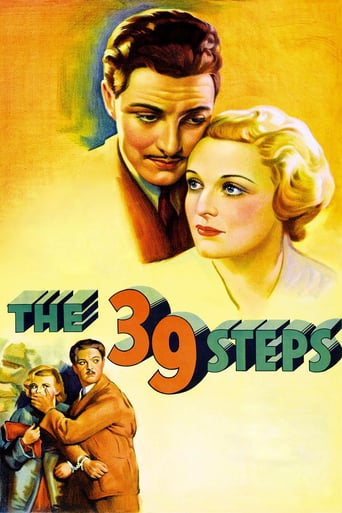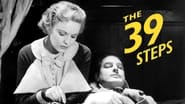zkonedog
Though not the first film ever produced by the hand of Alfred Hitchcock, "The 39 Steps" is considered the starting point for film buffs to watch the suspenseful Hitchcock film library. Considering it was made in 1935, this early effort holds up remarkably well.For a basic plot summary, this is a classic spy tale. When a female informant (played by Lucie Mannheim) turns up dead in the apartment of Richard Hannay (Robert Donat), Hannay makes it his personal quest to continue her final mission.Of course, being made in the 1930s, this movie has a different tone than those made today. Back in those days, you could get by with making motion pictures for mass entertainment (viewed at cinema palaces). Hitchcock does that a little bit, but luckily (since he's Hitch) he's smart enough to make a solid film AND entertain at the same time.Overall, I doubt there were too many films like this back in the 30s. It has a solid (if overdone, by today's standards) plot, engaging characters, and even some doses of much-needed humor to lighten the mood from time to time. So, if you are looking to experience all that Alfred Hitchcock has to offer and want to start at the beginning, "The 39 Steps" should be your first rental!
Rainey Dawn
This film is a great example of why we love to watch Alfred Hitchcock. Not only is this a good mystery-thriller (written by John Buchan, Charles Bennett, & Ian Hay) but it is well directed by Alfred Hitchcock. He was always very good at making his films very suspenseful (even his silent romantic films had trace elements of suspense in them).The film is exactly as the plot reads - but so much better than described: Richard Hannay is a visitor to London and finds himself mixed up in a case of murder with secret agents on his tail and he is determined to break up this massive spy ring.If you like spies/secret agent films, a murder mystery, and/or Alfred Hitchcock then you might like this film - it's one of Hitchcock's best movies and worth watching.8/10
disinterested_spectator
It is often said that in old movies, even husbands and wives had to sleep in twin beds, and if both got on the same bed, at least one foot of one person had to be on the floor. Actually, if that was a rule, it was never written down, because it is nowhere to be found in the Production Code. And if it was a rule, it was not followed in this 1935 movie, because an unmarried man and woman get in a double bed and spend the night with all four feet on the bed. Part of the reason may have to do with the fact that the movie was made in the United Kingdom. Maybe their censorship rules were different, and America just went along. Also, it probably helped that the man and woman are antagonistic toward each other, sleeping together only because of handcuffs, so that there is not the slightest suggestion that they will have sex with each other.At the end of the movie, Hannay calls out to Mr. Memory during a performance, asking, "What are the 39 steps?" to which Mr. Memory begins to answer before he is shot, thereby leading to the capture of the man who shot him, who heads the organization of spies. We have to wonder why Mr. Memory started answering the question. We suspect there are two reasons: first, Mr. Memory was a somewhat unwilling participant in the spy ring (blackmail?); and second, his pride in being able to answer any factual question that was put to him made him unable to say, "I don't know."But that started me thinking. This is not the only Hitchcock movie in which a villain blurts out the truth even though in so doing he provides information that could or does lead to his undoing. In "Spellbound" (1945), Constance (Ingrid Bergman) gets her colleague, Dr. Murchison (Leo G. Carroll), to help her figure out the meaning of a dream, which he does, thereby incriminating himself. In "Shadow of a Doubt" (1943), Uncle Charlie (Joseph Cotton), the Merry Widow murderer, vehemently expresses his disgust for foolish widows at the dinner table. In "Frenzy" (1972), Blaney (Jon Finch) is being hunted by the police for being the Necktie Strangler. He turns to Rusk (Barry Foster) for help, not realizing that Rusk himself is the Necktie Strangler. While they are talking, Rusk says with a hostile tone in his voice that some of these women who are raped and murdered get exactly what is coming to them, but Blaney is too distracted to notice.And come to think of it, I suppose we all have had moments when we blurted out something incriminating, when we could have simply kept our big mouths shut.
l_rawjalaurence
Forget the other two film versions (from 1959 and 1978) as well as the long-running stage adaptation that has graced the London stage for several years now. Hitchcock's version of the John Buchan classic still has the power to surprise and astonish eighty years after its premiere.Basically it has very little to do with the Buchan source-text: Hitchcock merely takes the title ("The Thirty-Nine Steps") as a pretext for constructing a highly entertaining comedy-thriller that's not without its sinister overtones - for example the sado- masochistic implications of Richard Hannay (Robert Donat) and Pamela (Madeleine Carroll) being chained together by the hands as they try to escape the clutches of Professor Jordan (Godfrey Tearle) and his gang. The two roam the Scottish Highlands and even spend the night together in a sequence notable for its sexual subtext.As with many of Hitchcock's British thrillers, THE THIRTY-NINE STEPS is replete with memorable supporting performances. As a noted stage actor of his day, Tearle comes across as polite, well-mannered and calm; the only indication we have of his sinister nature is the fact that one of his fingers has been severed (emphasized in a deliberate close-up). John Laurie is a suspicious Highland crofter, interested more in money than in sheltering Hannay and Pamela; his surly characterization contrasts with that of Peggy Ashcroft as his spouse, a tidy yet sympathetic woman (even if her Scottish accent is a little forced).The thriller comes to a head in an old-style variety theater, where Mr. Memory Man (Wylie Watson) is forced to admit the secrets of the Thirty-Nine Steps in the middle of his stage act, interrupting the performance and startling a packed house. Hitchcock shows a masterly grasp of popular culture of the time; the combination of sweat, dirt, good fellowship and classlessness that prevailed in variety theaters, contrasting starkly with the class-ridden world outside.Shot on a low budget, with some location shooting in Scotland as well as a memorable sequence where Hannay escapes on a train, this THIRTY-NINE STEPS is a unique cinematic experience.





